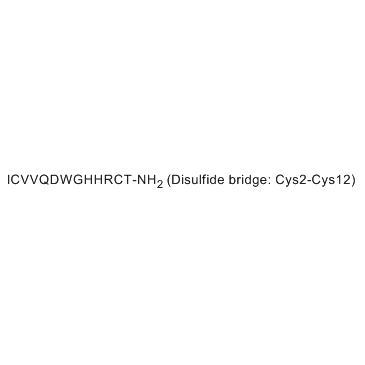Compstatin trifluoroacetate salt
Modify Date: 2024-01-03 22:23:03

Compstatin trifluoroacetate salt structure
|
Common Name | Compstatin trifluoroacetate salt | ||
|---|---|---|---|---|
| CAS Number | 206645-99-0 | Molecular Weight | 1550.77000 | |
| Density | N/A | Boiling Point | N/A | |
| Molecular Formula | C66H99N23O17S2 | Melting Point | N/A | |
| MSDS | N/A | Flash Point | N/A | |
Use of Compstatin trifluoroacetate saltCompstatinis is a 13-residue cyclic peptide, and a potent inhibitor of the complement system. |
| Name | Compstatin |
|---|---|
| Synonym | More Synonyms |
| Description | Compstatinis is a 13-residue cyclic peptide, and a potent inhibitor of the complement system. |
|---|---|
| Related Catalog | |
| In Vitro | Compstatin binds to baboon C3 and is resistant to proteolytic cleavage in baboon blood (similar to humans); Compstatin inhibits only the activation of primates' complement system[1]. |
| In Vivo | Compstatin (21 mg/kg) produces complete inhibition when given as a combination of bolus injection and infusion. Compstatin completely inhibits in vivo heparin/protamine-induced complement activation without adverse effects on heart rate or systemic arterial, central venous, and pulmonary arterial pressures[1]. Pig xenografts survival is significantlylonger in the Compstatin perfused group than in the control group. At rejection the biopsy samples obtained from kidneysperfused with Compstatin show less deposition of C3 and fibrin than do the control kidneys[2]. |
| Animal Admin | Compstatin-perfused circuit: pig xenografts are perfused with human blood containing Compstatin (final conc. 0.088 mg/mL). Control group: pig kidneys perfused with human blood and control agent. The total fluid volume, protein concentration and amount of blood are equal in both the Compstatin and control perfusion circuits, and the perfusion is performed in both circuits simultaneously with pooled blood from the same two donors. |
| References |
| Molecular Formula | C66H99N23O17S2 |
|---|---|
| Molecular Weight | 1550.77000 |
| Exact Mass | 1549.70000 |
| PSA | 704.58000 |
| LogP | 1.40260 |
| Storage condition | -20°C |
| H-Ile-Cys-Val-Val-Gln-Asp-Trp-Gly-His-His-Arg-Cys-Thr-NH2 |

